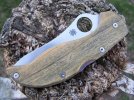- Joined
- Dec 5, 2005
- Messages
- 27,739
Apart from the fact that I'm not sure if I pronounce it right, I know that this wood is heavy, dense and oily. Makes for great propeller bushings and mallets as I understand it. www.lignum-vitae.com
Anyway, a buddy of mine who travels the seas on the Royal Canadian Navy Canoe, came across a beautiful chunk of the stuff when he was in the Caribbean, made a knife handle from a small piece of it and then gave me the rest.
I think I'm going to design another throwing knife using a bit of the stuff for some handle scales, and another bit of it for a large bush knife I've been working on the design of. I'm not sure what I'll do with the rest yet.
If any of you have any information, impressions, suggestions or ideas about this interesting wood, and it's use for knife handles, I would be very interested in reading them here. And, as always with cap in hand, photographs are always appreciated!
Anyway, a buddy of mine who travels the seas on the Royal Canadian Navy Canoe, came across a beautiful chunk of the stuff when he was in the Caribbean, made a knife handle from a small piece of it and then gave me the rest.
I think I'm going to design another throwing knife using a bit of the stuff for some handle scales, and another bit of it for a large bush knife I've been working on the design of. I'm not sure what I'll do with the rest yet.
If any of you have any information, impressions, suggestions or ideas about this interesting wood, and it's use for knife handles, I would be very interested in reading them here. And, as always with cap in hand, photographs are always appreciated!










